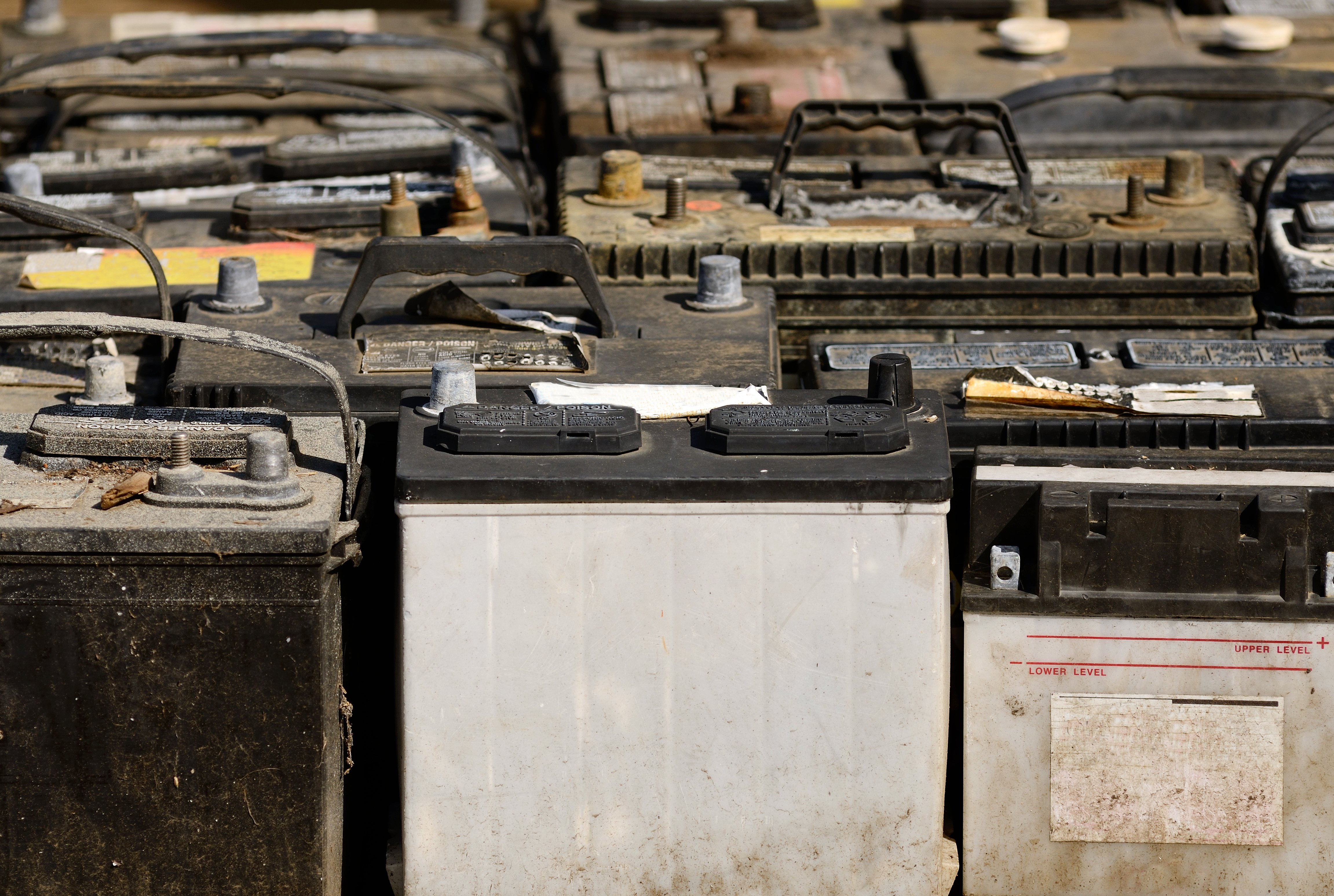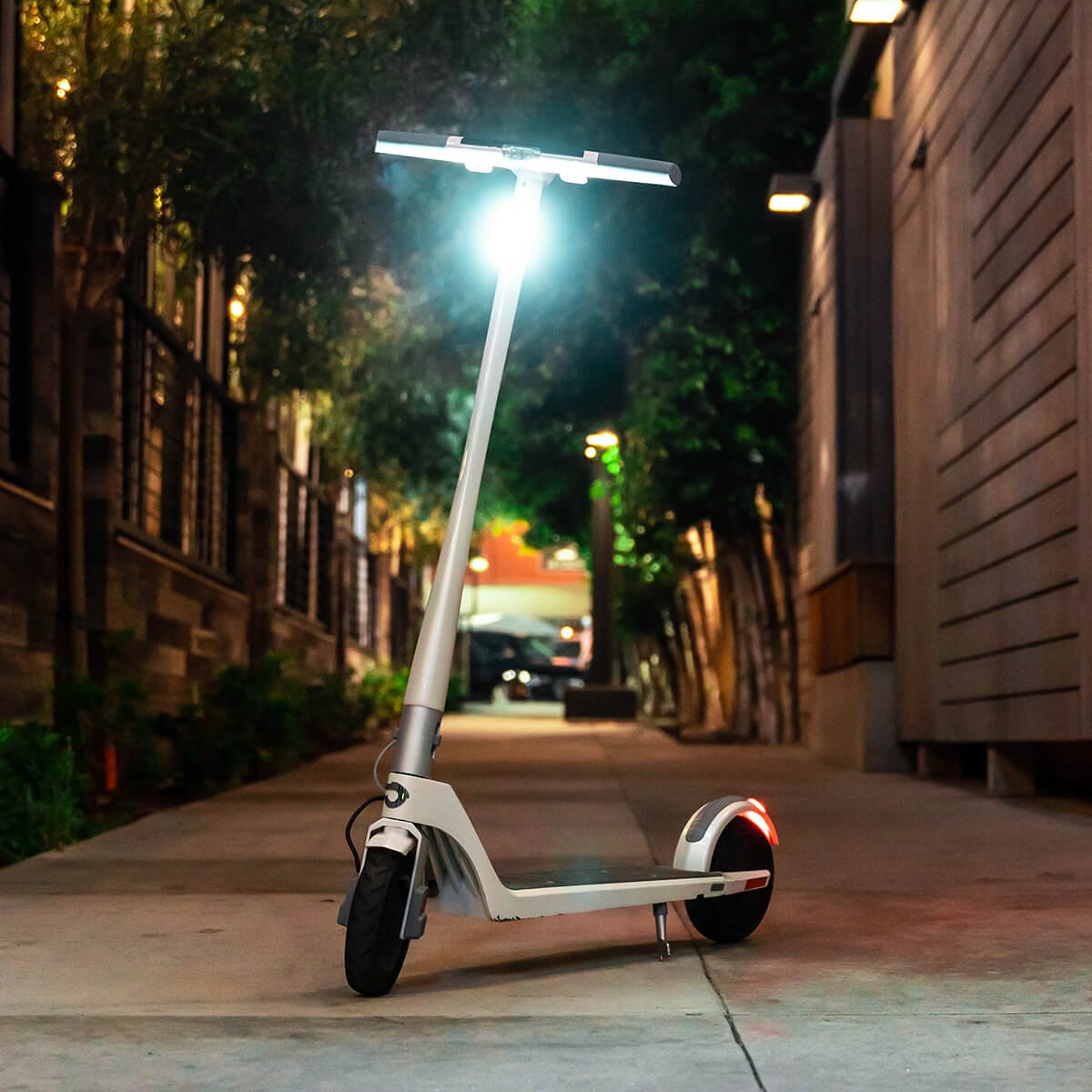Micromobility is here to stay, and it’s changing how we experience urban life for the better. With Unagi’s membership program, you can enjoy all the benefits of a top-tier electric scooter without the sky-high price of ownership or the inconvenience of ride-sharing.
Batteries are a key component of the global effort to decarbonize transportation. EVs use them to power the vehicle, while electric scooters and bikes offer people a more sustainable option for short trips. But, batteries have ramifications when they’re manufactured, used, and especially when they’re disposed. So, just what is the true environmental impact of your electric scooter battery?
Electric scooters: eco-friendly or foe?
As more and more of us make efforts to reduce our carbon footprint and prioritize protecting the environment, electric scooters are fast becoming the go-to transportation option for eco-conscious commuters.
And the battery is the most important part of your electric scooter. It's what propels you forward and keeps you moving, so it makes sense that you should choose one that will do the least amount of harm to the environment.
But, while the electric scooter overall is an excellent eco-friendly, cost-effective commuting choice, is your electric scooter battery environmentally friendly?
Why are batteries generally bad for the environment?

The truth is, no matter what materials are used to make a battery or how it is recycled, all batteries offer an environmental concern. Why?
Well, for starters, batteries are designed to be thrown away, but that's not all...
Disposable
This is a tough pill to swallow, but it's true: most batteries are designed to be used for a short period of time and then discarded. They're not made to last forever.
The reason for this is simple: batteries contain chemicals that can be dangerous if not disposed of properly. And the best way for manufacturers to ensure the safety of their products is by making sure people don't hold onto them past their expiration dates or use them when they no longer have power.
Toxic
Batteries typically contain toxic chemicals such as lead, mercury, cadmium and nickel. These metals are intentionally added to the battery's cell chemistry because they are good conductors of electricity. But, once the batteries have reached their end-of-life, these same elements can leak into the environment when improperly disposed of and contaminate soil or groundwater.
Energy intensive production
A battery is made up of many different materials, and in order to make new batteries, we need to mine and refine these raw materials like lithium and cobalt, which requires a large amount of energy. These processes put a large strain on the environment through heavy use of fossil fuels and toxic chemicals.
Non-BIODEGRADABLE
While batteries are designed as a disposable commodity, the majority of batteries are non-biodegradable, meaning they don’t break down over time. Instead, they just get buried in landfills and stay there for hundreds of years, leaching toxic chemicals into the soil and groundwater when they're exposed to moisture.
Expensive to recycle
Batteries are difficult to recycle - firstly, not all types of batteries have the same components or even the same amount of hazardous materials inside them. Meaning different types of batteries need different kinds of recycling processes in order for them to be stripped down so they can work properly when they're turned back into something else.
Secondly, battery recycling is not as efficient as other material recycling. Chemicals in batteries can be dangerous to workers and the environment. Plus, from an economic standpoint, it’s more expensive to recycle batteries than other materials like plastic or glass bottles.
Thirdly, too few people know how important it is to recycle batteries. Not everyone understands how much energy goes into making new batteries.
What is your electric scooter battery made from?
Most e-scooters use lithium-ion batteries, which are also found in mobile phones and laptops. This type of battery offers many advantages over other kinds of battery tech.
Lithium-ion batteries
Lithium-ion batteries are the most common type of rechargeable battery. You’ll find them in laptops, mobile phones and electric cars. They have a higher energy density than other types of batteries – which means they can store more energy per kilogram – and don’t degrade as quickly over time.
Lithium-ion batteries are a good choice for electric vehicles because they are lightweight, small and powerful, they're also flexible, have great longevity and are incredibly safe. Because they have a high energy density, they can store more power in less space. These properties make them ideal for powering your electric scooter.
However, that doesn't mean they're without their faults.
The typical li ion battery is made with cobalt and nickel
Firstly, the average electric scooter battery contains cobalt. While cobalt is a mineral ore that is extracted from the earth, it can be harmful to the environment if it isn't extracted properly.
Still, compared to lead-acid batteries - the typical battery you find in a motor vehicle, lithium-ion batteries are much more environmentally friendly.
Well, almost.
Lithium ion battery vs lead acid battery

Lithium ion batteries are used in many consumer electronics and electric vehicles. They're more compact, lighter and more efficient than lead acid batteries. They also have three times the lifespan and can be charged much faster.
However, lithium ion manufacturing is more environmentally damaging than manufacturing lead acid batteries – it uses high temperatures to convert lithium from raw materials into a stable form (lithium carbonate), which requires several steps and produces waste products such as sulfuric acid.
So, how are they better for the environment for lead acid batteries?
Lithium ion batteries are more efficient

Lithium ion batteries have higher power per weight than lead acid batteries. In other words, they can provide a lot of juice in a relatively small space and weight.
For example, lithium-ion battery packs used in electric vehicles are usually about 1/3 the size and weight of comparable lead-acid battery packs. The reason for this is that lithium has much higher energy density than lead, which allows it to store more energy in less space or volume.
This makes lithium ion batteries ideal for use in applications where compactness is important such as consumer electronics like cell phones or laptops; electric cars, spacecrafts, drones, and most electric scooters.
Lithium ion batteries are more environmentally friendly long term
Lithium ion batteries are more energy intensive to manufacture than lead acid batteries, due to the complexity of manufacturing. This means that lithium ion batteries have a higher carbon footprint during their lifecycle.
However, this is offset by the fact that lithium ion battery recycling rates are much higher than those of lead acid batteries. Recycling rates for lithium ion batteries are over 12%, compared to only 6% for lead acid batteries.
Also, the longer life cycle of lithium ion technology helps reduce the number of new batteries that must be manufactured and disposed of. In addition, because lithium ion battery systems have much smaller amounts of toxic materials than lead acid storage systems, there is less risk from improper disposal or accidental exposure at recycling facilities.
LiIon batteries have a lesser impact on the environment
Although lithium ion batteries have a higher carbon footprint, they last longer, are lighter, and more portable. Plus, the overall environmental impact of powering scooters, cars and homes with these types of battery is lower.
This means that even though it takes more energy to manufacture lithium ion batteries, the total amount of greenhouse gas emissions produced over their lifetime is less than if we were to use lead acid batteries.
That's because lead acid batteries last for about four years before they need to be replaced or recharged; lithium ion can go up to 10 years without needing replacement. This translates into lower carbon emissions overall due largely in part because these types of batteries require less frequent replacement/recharging cycles. Thus reducing waste generated throughout their lifetimes when compared against other types of batteries, such as nickel-metal hydride or nickel cadmium models, which have shorter life spans and require frequent replacements.
Finally, a lithium battery has twice the capacity as lead acid batteries, so you can get twice as much power from the individual battery cells in your battery pack.
Plus, they can also be recharged AND they charge much faster than rechargeable lead-acid and nickel metal hydride batteries. You can recharge a lithium ion battery in as little as one hour, compared to the eight hours it takes for a lead-acid battery and five hours for a nickel metal hydride battery.
Addressing the two main environmental impacts of e-scooter batteries: production and disposal

Production of lithium-ion battery
The lithium-ion battery uses less materials to make than disposable batteries do. And because they don't require lead or acid as part of its chemical makeup, means that they can more easily be broken down into their constituent parts and recycled and reused as part of other products.
The electric scooter battery is also more environmentally friendly because it doesn't contain any harmful chemicals like mercury or cadmium, both of which are present in disposable batteries. Mercury is dangerous for humans to ingest and causes neurological damage over time when inhaled. Cadmium has been linked with cancerous tumors in rats exposed to high doses through inhalation or ingestion.
Disposal of li ion battery
The good news is that most electric scooter batteries can be recycled. The bad news is that most people don't know how.
It's quite complicated to recycle your batteries, so pay attention...
Here's how to recycle your electric scooter battery:
- Turn off your electric scooter.
- Remove the dead battery from your electric scooter.
- Locate a battery recycling facility nearby.
- Take your battery to the center and drop it off.
Did you get that?
How to dispose of your electric scooter batteries responsibly
In all seriousness, if a lithium ion battery used in an electric scooter is properly disposed of, it shouldn't pose any environmental danger whatsoever.
The reason for this is that lithium ion batteries can be recycled at many facilities around the country. For example, if you live in California or New York and your local waste management center has a recycling program for rechargeable batteries and electronic devices, then you can bring them there yourself.
If not, then you'll have to take the battery somewhere else (either locally or remotely). Many battery manufacturers actually run their own recycling programs as well—these are usually free of charge and the companies offer convenient pickup options such as drop-off locations at partner stores.
Electric scooter batteries are getting better and better

Given how quickly technology is developing, it is likely that we will soon see batteries that are even more durable and last even longer. This means that you will be able to travel farther and quicker than ever.
Market analysts and technology experts predict that, over the coming ten years, electric scooters will become the preferred mode of personal mobility. Compared to the estimated 774,000 publicly accessible e-scooters in 2019, there are anticipated to be 4.6 million shared e-scooters globally by 2024.
Because there is such a demand for electric scooters, this will continue to pressure manufacturers to design more eco-friendly batteries as more environmentally conscious consumers enter the market.
The reason why there is an upsurge in demand?
1. Battery technology advancement
Battery technology has been cited at various points in the history of electric scooters as one of the significant obstacles to their widespread growth.
Now, the number of batteries required to power electric scooters has drastically decreased, and average battery life, battery capacity, and battery voltage has improved, thanks to recent developments in battery generation and lithium-ion batteries.
Electric scooter manufacturers in the past had a preference for lead-acid batteries. But, as reputable manufacturers make the switch away from lead acid batteries towards lithium-ion batteries, experts predict more climate conscious computers will hop on the bandwagon.
2. The potential market reach
Ninety percent of the world's shipments of electric scooters in 2016 originated from the Asia-Pacific region, which generated the majority of the industry's revenue.
But, since the advent of shared electric scooters, with companies such as Lime and Bird bursting onto the scene in 2017, which considerably increased the global reach of the electric scooter sector in the European and North American markets (especially the US market), there has been a tremendous uptake and demand for electric scooters.
So, are electric scooter batteries bad for the environment?

Well, yes in the short term, no in the long term.
Electric scooters take their energy from a rechargeable battery on board, so the carbon footprint is zero except for the electricity used to charge the scooter.
However, as talked about above, rechargeable batteries are an environmental concern. Rechargeable batteries in many electric scooters are made with lithium. Producing lithium requires large amounts of water and high heat. What's more, lithium leaches into the soil and water during mining operations, affecting the local populations and ecosystems.
When properly disposed of, though, an electric scooter battery can be recycled and have its rare-earth elements extracted.
Companies like Tesla recycle electric car batteries to be reused in their energy storage systems and power walls, while Chevy repurposes electric vehicle batteries for backup power at data centers.
These efforts help reduce waste that contains valuable materials to be reused or repurposed, where it would otherwise be left to rot in landfills for hundreds of years.
In a nutshell, modern electric scooter batteries - lithium ion batteries - are better for the environment than most other batteries.
Modern advancements in battery usage technology have led to rechargeable lithium-ion batteries that emit no carbon, easing concerns about the generation's potential influence on the environment.
Which means, leasing an electric scooter is one of the best decisions you can make if you live in a big city or frequently need to make the last-minute trip from the bus stop to your office, home, or grocery store.
To get your hands on an eco-friendly e-scooter, simply subscribe to Unagi, the finest scooter on earth, and pay monthly for your scooter subscription. Move around freely, cheaply and efficiently. Enjoy the journey safe in the knowledge that you're doing the world, your wallet, and your waistline a favor.
And remember, when the time comes to replace your electric scooter's battery, recycle it.

Stay current with the latest U.S. electric scooter laws in our 2025 guide. Updated annually since our first comprehensive guide, ensuring you have the most recent state and city regulations to ride responsibly”

The Slack Core 920R is currently the fastest electric scooter in 2025 that you can purchase without the need for pre-order.

Our selection of the best electric scooters 2025 spans the fastest e-scooters to the most portable ones, the ones designed for city riding and off-road, the best scooters for rain, budget electric scooters for students, and more powerful ones for skilled riders.

The Unagi Voyager is the best lightweight electric scooter for adults and teenagers. It is the ultraportable sequel to its predecessor, the Unagi Model One Classic.

If you're wondering whether an electric scooter with a seat is right for you, this is a detailed article that would suit your need.

Understand which personal electric vehicle is best, the choice between an electric bike or electric scooter might already be made for you by some critical factors, including portability and storage capacity.

In the U.S., most states don't require a license. For those that do, they usually just ask for a regular driver's license or a learner's permit.

Yes, you can bring an electric scooter on a plane, but it needs to have a lithium battery smaller than 100 watt-hours, which most don't.

Manufacturers advise against riding electric scooters in the rain. The main reasons are: water can fry the electronics, make the ride dangerous, and void your warranty.

The basis and the premise of my work is that we either operate out of love or we operate out of fear...Time is currency. The coolest thing about the scooters is that it's really quick, and it goes uphill. From there, traveling more efficiently and having a good time doing it--I think that's the most important thing.

Cynthia Leu has a full plate. A tech worker by day, Cynthia spends her off time balancing the parallel lives of a powerlifter, entrepreneur, mental health advocate, and more. Riding Unagi helps this USMC veteran cut down on everyday…

https://www.youtube.com/watch?v=7m2hVBE62LY Rasheed Muhammad is sick of Los Angeles traffic. In order to preserve his sanity, Rasheed has traded his everyday driving habit for the portable and beautiful Unagi Model One. It’s an essential accessory for navigating LA streets -- and…

Rich Lee, Co-Founder of San Francisco’s SPRO Coffee Lab, wants to share his love for coffee with the world. He depends on riding Unagi to avoid the hassle of navigating the parking crunch in the booming Mission Bay neighborhood.…












